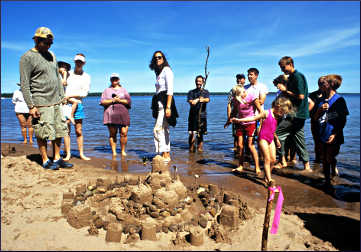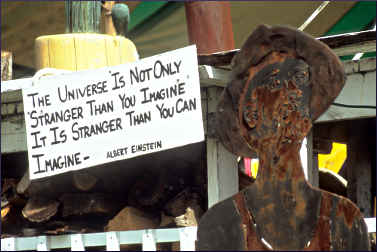Madeline's magnetism
The largest of the Apostle Islands has a personality rooted in an uncommon past.

© Beth Gauper
Over the centuries, waves of history have buffeted Madeline Island and given it as many variations as a Lake Superior agate.
This wooded island off Wisconsin's Bayfield Peninsula, the largest of the 22 Apostle Islands, exerts a magnetic pull.
The Ojibwe came from the east, led to "food that grows on water" — wild rice — by a cowrie shell in the sky, according to their origin mythology,
French fur traders followed and established the first fort in 1693. Rival Protestant and Catholic missionaries built the first churches and schools in the 1830s.
Well-to-do families from St. Paul and Nebraska built the first cottages in the 1890s, and their descendants and friends summer there still.
Now, thousands of vacationers and day-trippers come over each summer on ferries from Bayfield. Many head for rented cottages, melting into the woods that cover most of the 14-mile-long island.
The day-trippers bring bikes and take off on the quiet roads, or explore La Pointe by foot. La Pointe was a hub of the fur trade, a center of civilization when the rest of the Great Lakes region was frontier.
Now, it's a few blocks of little cafes and shops on either side of the dock, plus a museum, arts center and two small motels. In middle age, it's a place whose laid-back atmosphere attracts free spirits from all over.
Bulletin boards in the shops and cafes announce a bird-watching hike in the Wilderness Preserve, Irish music at the cafe and a concert by members of the St. Paul Chamber Orchestra, up for the annual music camp.
There might be a folk trio at Tom's Burned Down Cafe and a loom-making workshop at the Art Guild.
The Fourth of July is one of the best times to be on the island, which hosts a 1950s-style event that also evokes the pioneering 1850s, the fur-trading 1750s and a Brigadoon-like epoch that reappears yearly and is best described as Island Time.
It's the perfect expression of this little island, a historic crossroads where old money, new money and no money happily co-exist during the halcyon days of summer.

© Beth Gauper
From the yacht club comes peewee pirates; the wilderness-preserve association sends bumblebees in yellow tulle. A chef waves a spatula, teens from the music camp wave violin bows, an emu waves its long neck and children wave American flags.
Others wear papier-mache masks, puppets and costumes made at free, drop-in workshops at the Art Park, across from Tom's Burned-Down Café.
The parade always winds up on the lawn of the Madeline Island Historical Museum, where the Declaration of Independence is read and the crowd sings "America the Beautiful" and Woody Guthrie's "This Land Is Your Land."
Tom's Burned-Down Cafe is one part of island tradition, separated from the stars only by a bit of the old Big Top Chautauqua tent.
It's a folk venue and art salon, and sculptures from past steel-wrestling festivals adorn the lawn. Inside, hand-drawn placards provide commentary: "Normal is a setting on a washing machine."
There's another face of the island down the road at the yacht club, where some of the gleaming white vessels surpass ostentation.
They're only a few yards from the rustic old mission cemetery, where gravestones bear Ojibwe and French names and also modern offerings of pennies, trading cards, bead necklaces ad tobacco.
There are shin-high spirit houses and the graves of Chief Buffalo, negotiator of the 1854 Treaty of La Pointe, and Michel Cadotte, the fur trader and first settler whose Ojibwe wife was named Madeline.
It's a wonderful place to think about the past, but the Bad River Band, to whom the cemetery was deeded by the Catholic Church, has closed off access.
The cemetery, along with 200 acres now leased to cottagers, is all the Ojibwe have left on the island — whose Ojibwe name is Mooningwanekaaning, home of the yellow-breasted flicker bird — and that's a sore point.
"We've had traditionalists visit who say the whole island is sacred, and eventually it will return to the Ojibwe people," said Steve Cotherman of the Madeline Island Historical Museum.

© Beth Gauper
The superb museum, run by the Wisconsin Historical Society, ties the strands of history together with photos and words of all those who have come to the island, from picnickers with parasols to the Ojibwe, who said, "All the gifts the Creator gave our people were here."
Circling around the island, visitors find Big Bay State Park, whose long sand beach curves gracefully into a crescent, Caribbean-style, facing nothing but a long blue stretch of Lake Superior.
It looks enticing, but swimmers who dash in before late July, or even August, learn to dash out fast, before they can feel the cold.
At the north end of the beach, there are warmer waters at the lagoon of Big Bay Town Park, as well as campsites and canoe rentals for wildlife-watching in wetlands. On the south end of the beach, state-park trails lead hikers onto sandstone cliffs and ledges.
As a homeland, Madeline Island was bountiful, providing fish and protection from enemies. As a vacation spot, its attributes are more ephemeral, but just as appreciated.
Trip Tips: Madeline Island in Wisconsin's Apostle Islands
Getting there: The ferry leaves every half hour from Bayfield during the day in summer. 715-747-2051.
Annual events: Saturday before Memorial Day weekend, Madeline Island Marathon and Half Marathon. First weekend of June, open house at Big Bay State Park. Mid-June, Apostle Islands Inline Skate Marathon. July 4, Fourth of July celebration. Third weekend of October, Family Fall Festival.
Getting around: The island is ideal for bicycling; bring a bike on the ferry or rent in La Pointe from Motion to Go.
Big Bay State Park is seven miles from the ferry landing, so if you plan to camp, you'll need to bring a car.
Canoeing and kayaking: Apostle Islands Kayaks rents boats at its shop across from Joni's Beach in La Pointe, 715-747-3636.
Adventure Vacations offers kayak and boat tours around the island as well as paddleboard rentals.
Madeline Island School of the Arts: From May through October, this school on a restored dairy farm offers five-day classes in photography, drawing, painting, fiber arts and writing.
Students stay in four-room cottages next to woods and meadows. Breakfast and lunch is included in the rates. The campus is disabled-accessible.

© Beth Gauper
Madeline Island Historical Museum: It's a block from the ferry landing and well worth a visit. It's open daily from Memorial Day weekend through Labor Day, then Wednesday-Sunday through the third weekend of October. Admission is $10, $5 for children 5-12.
Nightlife: Tom's Burned Down Cafe keeps rising from the ashes, zanier than ever.
Musicians from the Madeline Island Music Camp play concerts at the Clubhouse from mid-June to mid-July.
Golf: The Madeline Island Golf Club has 18 holes designed by Robert Trent Jones, 715-747-3212.
Accommodations: The Inn on Madeline Island rents condos, cottages and private homes in all price ranges. Many lake houses rent by the week, 800-822-6315.
Farmhouse Kitchen and Inn offers six motel rooms next to the ferry landing.
There are dozens of private vacation rentals on Airbnb and VRBO.
Camping: There are 60 campsites at Big Bay State Park.
Big Bay Town Park has showers and tent and RV sites that can be reserved.
Dining: Cafe Seiche is a farm-to-table restaurant in downtown La Pointe.
Near the ferry landing, the Farmhouse serves breakfast and brunch.
Information: Madeline Island tourism, 715-747-2801.